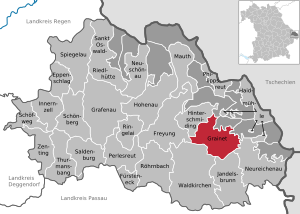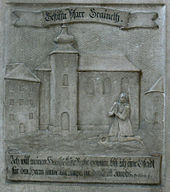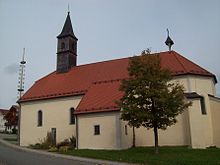Grainet
| coat of arms | Germany map | |
|---|---|---|

|
Coordinates: 48 ° 48 ' N , 13 ° 39' E |
|
| Basic data | ||
| State : | Bavaria | |
| Administrative region : | Lower Bavaria | |
| County : | Freyung-Grafenau | |
| Height : | 679 m above sea level NHN | |
| Area : | 36.13 km 2 | |
| Residents: | 2473 (Dec. 31, 2019) | |
| Population density : | 68 inhabitants per km 2 | |
| Postal code : | 94143 | |
| Area code : | 08585 | |
| License plate : | FRG, GRA, WOS | |
| Community key : | 09 2 72 121 | |
| Community structure: | 12 districts | |
| Address of the municipal administration: |
Obere Hauptstrasse 21 94143 Grainet |
|
| Website : | ||
| Mayor : | Jürgen Schano ( CSU ) | |
| Location of the municipality of Grainet in the Freyung-Grafenau district | ||
Grainet is a municipality and a village in the Lower Bavarian district of Freyung-Grafenau. The place is a state-approved resort .
geography
Geographical location
The municipality is located in the Danube Forest region in the southeastern Bavarian Forest . Grainet is located in a sunny valley basin at the foot of the 1170 meter high Haidel, around eight kilometers east of Freyung , nine kilometers north of Waldkirchen and 20 kilometers from the borders with the Czech Republic and Austria .
Community structure
There are twelve parish parts:
|
There are the markings :
- Böhmzwiesel
- For wood
- Grainet
- Rehberg
- Vorderfreundorf
Neighboring communities
history
Until the 19th century
Grainet was created around 1400 as a so-called mule village (from Middle High German Sam = horse load ) on the Goldenen Steig , an old trade route from Bohemia to Bavaria, which was first mentioned in 1010. The salt transports from Passau to the Bohemian Prachatitz were an important source of income for the poor Bavarian and Bohemian Forests in the late Middle Ages. Since the Thirty Years' War, the trade in “white gold” came to a standstill.
In 1803 Grainet, belonging to the bishopric of Passau , was secularized together with most of the high-estates area in favor of Ferdinand of Tuscany . Since the peace treaties of Brno and Pressburg in 1805, the place has belonged to Bavaria.
In 1897 the parish name Untergrainet was officially changed to Grainet .
Incorporations
On January 1, 1971, the previously independent communities of Fürholz and Rehberg were incorporated. On April 1, 1971, Vorderfreundorf was added.
Population development
Between 1988 and 2018 the community grew from 2,132 to 2,432 by 300 inhabitants or 14.1% - the highest percentage increase in the district in the period mentioned.
- 1961: 1830 inhabitants
- 1970: 1856 inhabitants
- 1987: 2112 inhabitants
- 1991: 2226 inhabitants
- 1995: 2383 inhabitants
- 2000: 2441 inhabitants
- 2005: 2429 inhabitants
- 2010: 2430 inhabitants
- 2015: 2391 inhabitants
politics
Municipal council
The municipal council consists of the first mayor and the council members.
Based on the local elections on March 15, 2020 , since May 1, 2020, the municipal council members have been made up of the following four groups:
- CSU : 6 seats
- SPD : 4 seats
- UWG Vfd. - FW : 2 seats
- Young Voters Union (JWU): 2 seats
mayor
The professional first mayor is Jürgen Schano (CSU). Since May 1, 2020, he has been the successor of Kaspar Vogl ( SPD ), who was elected in the local elections on March 16, 2014.
Finances
The municipal tax receipts in 2010 amounted to 892,000 euros; of which the trade tax income (net) amounted to 205,000 euros.
coat of arms
Grainet
|
Blazon : “Split by silver and green; in mixed up colors in front a vertically placed leafy stick, behind a bell. "
The green stick, which resembles a branch, refers to the place name, which is derived from “green”, and the legend of the origin of the settlement: a stray hiker vowed to build a chapel in case he was saved. After he had found his way again, he marked the construction site for the little church with his walking stick, which he found green on his return to the wilderness. The later settlement is said to have been named after this green staff. The bell, a so-called mule bell, is a reminder of the busy trade through Grainet. The salt carts used to take a break there in front of Leopoldsreut . The regular ringing of the bell should point the way to the salt mover on the Goldener Steig at night and in fog. |
|
For wood
|
Blazon : "In front in blue three left silver tips, behind in green a golden pole, covered with a silver lily."
Fürholz, located on the so-called Prachatitzer Steig, an important trade route between Passau and Bohemia, received privileges for the transport of goods from Bishop Otto von Lonsdorf in 1256. The Lonsdorf coat of arms reminds of this with the symbol of the street , the pole. The Niedernburg monastery in Passau had toll rights in Fürholz, hence the lily in a special design as Cleve , a reference to the Marienkirche in Niedernburg. |
|
Vorderfreundorf
| Blazon : "Above a black black grouse on a white background, below a crossed gold hook and a paring knife on a green background." | |
| Justification of the coat of arms: The black cock indicates the rich hunting grounds, trift hooks and paring knives, a so-called Scheppser , were needed by the men from Vorderfreundorf for the Holztrift on the Osterbach, which brought work and bread especially in the 19th century. |
Town twinning
-
 Czech Republic : A partnership agreement was signed in 1996 between the city of Prachatice and Grainet.
Czech Republic : A partnership agreement was signed in 1996 between the city of Prachatice and Grainet.
Honorary citizen
With the award of honorary citizenship, the municipality pays tribute to people who have made a special contribution to the municipality.
- Simon Forsthofer , (* 1838, † November 23, 1923 in Landau an der Isar ), pastor in Grainet from 1882 to 1893, founder of the Loan Association, builder of the church tower (1887/88)
- Josef Herkner († September 29, 1986 in Grainet), Episcopal-Spiritual Counselor, Pastor in Grainet from 1964 to 1984, awarded in 1984. In the laudation, Mayor Josef Grabmaier said: "You have sown good seeds that produced ripe fruits" , to which Herkner replied: "I have only done my duty" . He found his final resting place in an honorary grave in the cemetery in Grainet.
- Josef Rief , (born March 15, 1926, † September 5, 2002)
Culture and sights
Parish
Grainet belonged to the parish Freyung until 1750 . Four to five times a year the Freyung priest celebrated church services in the old Nikolauskirche, which had become much too small due to the population growth in the community. They turned to Cardinal Prince-Bishop Joseph Dominikus von Lamberg in Passau, who recognized the emergency but did not provide any money for a new church. The Passau innkeeper and ship master Lukas Kern (1681–1749), already known as a founder and benefactor, helped the poor forest dwellers and they were able to set up their own parish with a foundation of 10,000 guilders and start building a new church. With Fürholz, Gschwendet, Hochstein, Hobelsberg, Mitterling, Ohmühle, Rehberg, Ober- and Unterseilberg and Vorderfreundorf, with Auersbergsreut, Marchhäuser, Schnellnzipf (today parish of Bischofsreut), with Haidhäuser, Haidmühle, Ludwigsreut, Theresienreut (today parish of Haidmühle) with Duschlberg, Gschwendet, Leopoldsreut , Ostermühle, Schwendreut the pastor had to look after over 3,000 Catholics in the pastoral care of 1867. From 1794 two auxiliary priests ( cooperators ) stood by his side. Today, almost 4,000 Catholics and holiday guests are looked after in the parish association of Grainet, Herzogsreut, Hinterschmiding.
Parish Church of the Most Holy Trinity

The church was built from 1747 to 1756 according to plans by the Passau builder Severin Goldberger . The Passau painter Johann Georg Unruhe (1724–1801) created the original high altar with the altarpiece of the Assumption of the Virgin , taken from the Holy Trinity al fresco , that is, painted on fresh plaster. In 1823 the high altar of the 1803 secularized Franciscan Church in Passau was acquired. The wooden structure with stepped columns, pilasters and acanthus decorations, attributed to the Passau sculptor Matthias Högenwald (1681), extends to the vault. The altarpiece, painted in 1686 by Franz Ignaz Bendl (Pendl), shows the coronation of Mary by the Holy Trinity. On both sides there are larger than life St. Ludwig and St. Bonaventure. In the elevator above there is an oval image of the Virgin Mary, flanked by two other Franciscan saints and two angels. The side altars, also originally frescoed, were visible again during the last renovation in 1999 and have since been repositioned by the wooden superstructures made in 1826 by the Hutthurm master carpenter Mathias Schmidt. The lost oil paintings of the patron saints of the donor couple Lukas and Theresia Kern have been replaced by motifs of the Passion of Christ. The altar leaves are framed by two columns, and two motifs in the elevator are decorated with putti on the sides. Wooden sculptures from the 15th and 18th centuries are distributed throughout the nave. A Fatima Madonna is located above the baroque baptismal font. The organ stands on a double gallery above the main entrance, a Gothic mount of olives is placed in the side entrance. In 1887/88 the simple roof turret was replaced by a tower one meter high with a four-part bell. The altar and ambo were designed in 1975 in Leopold Hafner's sculpture workshop .
Nicholas Church
The Nikolauskirche , built around 1500, is around twice as old as the new parish church , but it was completely destroyed in the great village fire on September 8, 1911, in which six residential buildings with outbuildings burned down. An eyewitness reported that the roof turret looked like a burning candle. That the high altar could be saved borders on a miracle. The altarpiece, the church patron St. Nicholas of Myra with St. Barbara and St. Catherine , flanked by two twisted columns crowned with vine leaves, dates from the middle of the 17th century. A Madonna and Child around 1450, Saint Sebastian (early 16th century) and other baroque figures adorn the church interior.
Kohlstattbrunn
The pilgrimage site of Kohlstattbrunn is located in the forest on the way between Hobelsberg and Gschwendet. A spring at a place where the Fürholzer blacksmiths operated their charcoal piles was said to have healing properties, especially for eye problems. The pilgrimage to Kohlstattbrunn is a so-called Bründl pilgrimage . The main festival is celebrated every year on the Assumption Day (August 15th) and is considered the largest pilgrimage in the lower Bavarian Forest. In the stone church built in 1895, a votive plaque tells the story of how the place of pilgrimage came about. The corpse met Lorenz Seidl, a Häusler from Frauenberg; in gratitude for his salvation, he vowed to build the chapel.
Opposite is the Schächerkapelle , in which around a crucifixion group (1834), in addition to many votive tablets after prayers have been answered, mainly in the case of cattle diseases and diseases, wooden limbs (feet, legs, arms, hands) and crutches testify to the popular piety of the forest people.
More chapels
- 1950 St. Florian , Fürholz
- 1967 Our Lady of Fatima , Vorderfreundorf
- The village chapel in Oberseilberg, Maria unter den Linden , built in 1906, was renovated and modernized in 1993.
- Of stones broken homes 1987/88 which was in Obergrainet Pater- Rupert Mayer Chapel , built and decorated the altar of Karl Friedberger; the cross and the statue of Mary were carved by Johann Gutsmiedl, both from (Vorderfreundorf). The wooden bust of the patron saint was made by the artist Alfons Neubauer, who was born in Freyung. Alois Wudy painted the stained glass windows, donated by citizens of the Upper Grain. From the square in front of the chapel you have a beautiful view of the Graineter basin .
- The new chapel of Our Lady of Sorrows in Rehberg was built in 1964. The old village chapel was moved to the eastern entrance to Rehberg. A Waffen-Christi cross ( Arma Christi ) from the 18th century with 35 tools of torture and some rococo figures decorate the interior.
- The original Unterseilberg village chapel is still preserved. Built in 1766, it is a gem of rural and rural folk art of the late Baroque and, in this intactness, an extremely rare example of baroque popular piety. Builders and painters are unknown, the chapel belongs to the Glaserhof and is privately owned. On the small baroque altar stands a Christ on the scourge column, above it on a cloud God the Father, in between the Holy Spirit in the form of a dove. St Nicholas and Erasmus stand to the side of the half-columns. Sitting and kneeling angels carrying luminous lights complement the altar structure. The fully painted chapel depicts the history of salvation and passion in 23 pictures.
- In Ohmühle, between Rehberg and Fürholz, there is a plague column from 1639 and the grave chapel , an inconspicuous wooden structure whose origin is unknown.
- St. Sebastian in Kronwinkel was built in 1991.
- The Marienkapelle in Exenbach was rebuilt in 1993.
- St. Koloman , the Heiligbründl pilgrimage chapel outside Exenbach, dates back to 1656. The small wooden chapel, almost ruined in 1734, was renovated in the middle of the 18th century. The spring next to the chapel once rose next to the altar.
Architectural monuments
Economy and Infrastructure
Economy including agriculture and forestry
According to official statistics, there were 97 employees at the place of work in the manufacturing sector and 20 in the trade and transport sector. In other economic areas, 64 people were employed at the place of work subject to social security contributions. There were a total of 817 employees at the place of residence subject to social security contributions. There were none in manufacturing and seven in construction. In addition, in 1999 there were 95 farms with an agricultural area of 1169 hectares, 958 hectares of which were permanent green space.
education
The following institutions exist (as of: 1999):
- 75 kindergarten places with 69 children
- a primary school in the school association with the secondary school in Hinterschmiding
See also
Web links
- Local government
- Tell about the creation of Grainet
- For wood
- Grainet: Official statistics of the LfStat
Individual evidence
- ↑ "Data 2" sheet, Statistical Report A1200C 202041 Population of the municipalities, districts and administrative districts 1st quarter 2020 (population based on the 2011 census) ( help ).
- ↑ a b Mayor / Lord Mayor in municipalities belonging to the district (as of May 1st, 2020). (xlsx) Bavarian State Office for Statistics, accessed on June 12, 2020 .
- ↑ [1]
- ↑ a b Wilhelm Volkert (Ed.): Handbook of the Bavarian offices, communities and courts 1799–1980 . CH Beck, Munich 1983, ISBN 3-406-09669-7 , p. 596 .
- ↑ Announcement of the final result of the election of the municipal council on March 15, 2020. Grainet community election officer, accessed July 3, 2020 .
- ^ Political organs of the community. Grainet Parish, accessed August 3, 2020 .
- ↑ PDF at www.statistik.bayern.de
- ↑ a b c Entry on the coat of arms of Grainet in the database of the House of Bavarian History
- ^ Passau, St. Paul parish church, epitaph of Lukas Kern, detail, text: Gestiffte Pfarr Graineth. I don't want to give my head any rest, if I bit I find a city for the Lord, a (?) Temple for the god Jacob. Ps. 131 V. 5.
- ^ Grainet Catholic parish - 250 years of Grainet parish June 18, 2000
- ↑ The legend of the origins of the Kohlstattbrunn pilgrimage chapel
- ^ Peter Dillinger: Graineter Kapellenweg









